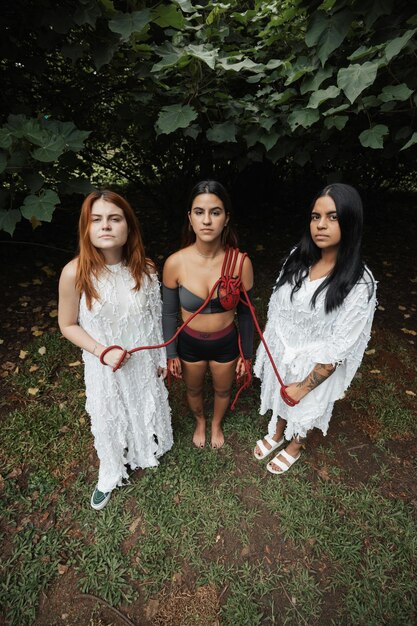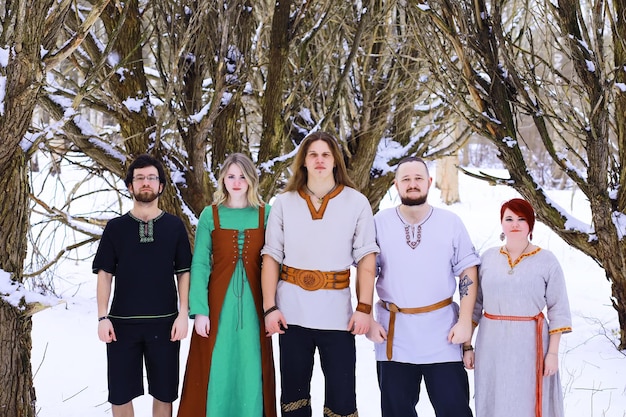Paganism in Modern US: Ancient Beliefs Shaping Subcultures

Paganism in modern US subcultures represents a revival and reinterpretation of ancient polytheistic and earth-centered beliefs, influencing contemporary identity, spirituality, and community formation.
The resurgence of Paganism and Modernity: How Ancient Beliefs are Shaping Contemporary US Subcultures showcases a fascinating interplay between ancient spiritual traditions and modern societal trends, particularly within diverse subcultures across the United States.
Understanding Modern Paganism
Modern Paganism is a broad term encompassing a variety of contemporary religious and spiritual movements that draw inspiration from pre-Christian belief systems. These movements often emphasize a deep connection with nature, the reverence of multiple deities, and the practice of magic and ritual.
Unlike established religions, modern Paganism is characterized by its decentralized structure and diverse interpretations, allowing individuals and groups to tailor their beliefs and practices to their own spiritual needs and experiences.
Core Beliefs and Practices
Modern Pagan beliefs typically include polytheism or pantheism, the worship of gods and goddesses from various pantheons, and a focus on the cyclical nature of life and the changing seasons. Rituals and celebrations often involve honoring the elements, connecting with ancestral spirits, and practicing various forms of divination and energy work.
- Polytheism: The belief in and worship of multiple deities, each with their own unique attributes and domains.
- Animism: The belief that all things, including plants, animals, and natural features, possess a spirit or soul.
- Ritual and Magic: The use of ritual practices and magical techniques to connect with the divine and influence the world around them.
- Nature Worship: A deep reverence for the natural world and its cycles, often expressed through seasonal celebrations and ecological activism.
Paganism, in its modern form, values personal experience and intuition, encouraging individuals to explore their own spiritual path and develop a personal relationship with the divine.
Historical Roots and Influences
Paganism’s roots can be traced back to ancient polytheistic religions practiced throughout Europe, the Middle East, and beyond. These traditions were largely suppressed by the rise of Christianity, but elements of them survived in folklore, folk magic, and various esoteric traditions.
The modern Pagan revival began in the late 19th and early 20th centuries, with the emergence of movements such as Wicca and Druidry, which sought to reconstruct and revitalize ancient Pagan practices and beliefs.

Key Figures and Movements
Several key figures and movements played a crucial role in shaping modern Paganism, including Gerald Gardner, the founder of Wicca, and Aleister Crowley, a controversial occultist who influenced many modern Pagan practices.
- Gerald Gardner: Often credited as the “father of Wicca,” Gardner developed a system of witchcraft based on his interpretations of historical sources and esoteric traditions.
- Aleister Crowley: A controversial figure in the occult world, Crowley’s teachings on magic and personal empowerment influenced many modern Pagan groups.
- Doreen Valiente: A prominent Wiccan author and High Priestess, Valiente helped refine and popularize Gardnerian Wicca.
Modern Paganism continues to evolve and adapt, drawing inspiration from a wide range of sources and reflecting the diverse spiritual interests of its practitioners.
Paganism’s Appeal in Modern Society
The appeal of Paganism in modern society can be attributed to several factors, including its emphasis on individual empowerment, its connection with nature, and its inclusive and accepting worldview.
Many individuals are drawn to Paganism as an alternative to traditional religions, which they may find dogmatic, patriarchal, or out of touch with their spiritual needs.
Reasons for Choosing Paganism
Paganism offers a spiritual path that emphasizes personal growth, self-discovery, and a direct connection with the divine. It also provides a sense of community and belonging for individuals who may feel marginalized or alienated by mainstream society.
- Personal Empowerment: Paganism encourages individuals to take control of their own spiritual path and develop their unique gifts and talents.
- Connection with Nature: Paganism fosters a deep appreciation for the natural world and a sense of responsibility for its protection.
- Inclusive Community: Pagan communities often welcome individuals from diverse backgrounds and identities, providing a safe and supportive space for spiritual exploration.
Paganism provides a framework for individuals to explore their spirituality in a way that resonates with their personal values and experiences.
Pagan Subcultures in the US
Modern Paganism has given rise to a variety of distinct subcultures in the United States, each with its own unique focus and practices. These subcultures reflect the diversity of Pagan beliefs and the diverse interests of its practitioners.
Some of the most prominent Pagan subcultures include Wicca, Druidry, Asatru, and Heathenry, each with its own distinct pantheon, rituals, and community structure.

Examples of Pagan Subcultures
Wicca, perhaps the most well-known Pagan tradition, focuses on the worship of a Goddess and God, the practice of magic, and the celebration of seasonal festivals known as Sabbats. Druidry emphasizes a connection with nature, the wisdom of trees, and the veneration of ancestors. Asatru and Heathenry are reconstructions of ancient Norse and Germanic pagan religions, focusing on the worship of gods such as Odin, Thor, and Freyja.
- Wicca: A modern Pagan religion emphasizing witchcraft, magic, and the worship of a Goddess and God.
- Druidry: A nature-based spirituality that honors the wisdom of trees, the cycles of the seasons, and the spirits of the land.
- Asatru/Heathenry: Reconstructions of ancient Norse and Germanic pagan religions, focusing on the worship of gods such as Odin, Thor, and Freyja.
These subcultures provide individuals with a sense of identity, community, and spiritual purpose, allowing them to connect with ancient traditions in a modern context.
Challenges and Misconceptions
Despite its growing popularity, Paganism continues to face challenges and misconceptions in mainstream society. These challenges range from prejudice and discrimination to misunderstandings about Pagan beliefs and practices.
One of the most common misconceptions about Paganism is that it is evil or Satanic, due to its association with witchcraft and magic. This misconception is often fueled by fear and ignorance, and it can lead to discrimination and persecution against Pagan individuals and communities.
Addressing Misconceptions
It is important to address these misconceptions and promote a more accurate and nuanced understanding of Paganism. This can be achieved through education, outreach, and by sharing personal stories of Pagan individuals and communities.
- Education: Providing accurate information about Pagan beliefs and practices through books, articles, websites, and public lectures.
- Outreach: Engaging with mainstream media and organizations to promote a more positive and accurate portrayal of Paganism.
- Personal Stories: Sharing personal stories of Pagan individuals and communities to help dispel stereotypes and promote understanding.
By challenging these misconceptions and promoting a more informed understanding of Paganism, we can create a more inclusive and accepting society for all.
The Future of Paganism in the US
The future of Paganism in the US looks promising, as more and more individuals are seeking alternative spiritual paths that resonate with their values and experiences. The growing awareness of Paganism and its diverse subcultures is also helping to break down stereotypes and promote understanding.
As Paganism continues to evolve and adapt, it is likely to play an increasingly important role in shaping contemporary US subcultures and contributing to the spiritual landscape of the nation.
Trends and Predictions
Several trends and predictions can be made about the future of Paganism in the US, including the increasing use of technology to connect and share information, the growing focus on social justice and environmental activism, and the continued diversification of Pagan beliefs and practices.
- Technology: The use of online platforms and social media to connect with other Pagans, share information, and organize events.
- Social Justice: The integration of social justice principles into Pagan spirituality, focusing on issues such as environmentalism, LGBTQ+ rights, and racial equality.
- Diversification: The emergence of new Pagan traditions and practices that reflect the diverse interests and experiences of its practitioners.
Modern Paganism promises a vibrant and dynamic future, empowering individuals to connect with the divine, with nature, and with each other in meaningful ways.
| Key Point | Brief Description |
|---|---|
| 🌿 Nature Connection | Paganism emphasizes a deep connection with nature and its cycles. |
| ✨ Personal Empowerment | Individuals take control of their spiritual path, fostering self-discovery. |
| 🤝 Inclusive Community | Pagan communities welcome diverse backgrounds and identities. |
| 🛡️ Addressing Misconceptions | Efforts to educate and dispel stereotypes about Pagan beliefs. |
Frequently Asked Questions
▼
Modern Paganism is a collection of contemporary religious movements inspired by pre-Christian traditions, focusing on nature, polytheism, and ritual practices.
▼
Common beliefs include polytheism, animism, the cyclical nature of life, and the importance of connecting with the natural world.
▼
Paganism is often decentralized, emphasizes personal experience, and allows for diverse interpretations, unlike more structured traditional religions.
▼
Examples include Wicca, Druidry, Asatru, and Heathenry, each with its own unique focus and practices based on ancient traditions.
▼
Pagans often face misconceptions, prejudice, and discrimination due to misunderstandings about their beliefs and practices in mainstream society.
Conclusion
Modern Paganism represents a vibrant and evolving spiritual landscape in the United States. As ancient beliefs are reinterpreted and integrated into contemporary subcultures, Paganism continues to offer individuals a meaningful connection with nature, personal empowerment, and a sense of community.





